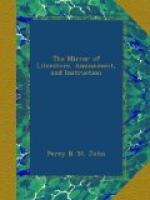What a picture is this of the wild luxuriance of nature
devastating the trim and chiselled glories of art!
Next is Scotney Castle, the ancient part of which
is said to have been a fortress in the reign of Richard
II.; the moat still remains. The author hints
that the tour may be advantageously extended to Bodiam
Castle; Winchelsea, near which is Camber, one of the
fortresses built by Henry VIII. to guard the south
coast; Battle Abbey, founded by William the Norman,
and calling up in review the battle of Hastings, and
the Bayeaux tapestry; the Roman fort of Pevensey;
and Hurstmonceaux Castle built by Roger Fiennes, treasurer
to King Henry VI. Returning to the Wells, and
in the more immediate vicinity, are Somer Hill, whose
chase, manor, and appurtenances were conveyed by Queen
Elizabeth to her favourite Dudley, Earl of Leicester,
and subsequently to the widow of the magnanimous but
ill-fated Earl of Essex; also, Great Bounds, of the
age of Elizabeth, and conveyed to her relative Henry
Cary, Lord Hunsden. Come we then to Tunbridge
Castle, built by De Tonbridge, a kinsman of the Conqueror,
who came with the invaders to share the spoil of their
victory: “here, it is said, he congregated
his retainers and vassals. These were all called
into active service soon after the death of William
I.,” for De Tonbridge, (or Earl Clare, as he
had been created,) espoused the cause of Robert Curtoise,
in opposition to William Rufus, who had seized the
crown. The castle is described by Mr. Britton
with interesting and not dry-as-dust minuteness, although
only some dilapidated and almost undefinable fragments
remain. Tunbridge Priory and the Free Grammar
School are next mentioned, the latter in connexion
with Dr. Vicesimus Knox, who was master of the school
for some years.
[6] See Mirror, vol. xiv.
p. 66, and vol. xviii. p. 225.
Let us hope that the frequenters of the Wells will
not, in their grave moments, forget the olden glory
of Penshurst, about six miles N.W. of the gay
resort,—Penshurst, as Mr. Britton terms
it, “the memorable, the once splendid, but now
sadly dilapidated mansion of the Sydneys,” or
as Charlotte Smith sung with touching simplicity,
in 1788:
Upon
this spot,
Ye towers sublime, deserted now and drear,
Ye woods deep sighing to the
hollow blast!
The musing wand’rer loves to linger
near,
While History points to all
your glories past.
Yet, how can we enumerate the ancient fame of Penshurst
in this brief memoir; from Sir John de Poulteney,
who first embattled the mansion in the reign of Edward
II:, to Sir John Shelley Sydney, the present proprietor
of the estate; or how can we here describe the mansion,
wherein that pains-taking investigator, Mr. Carter,
in 1805, recognised the architectural characteristics
of the reigns of Henry II., Richard III., Henry VIII.,
Elizabeth, James I. and George I. and III. But
we must observe, “it is presumed, that whilst




